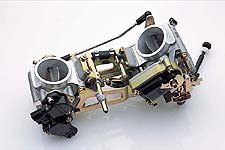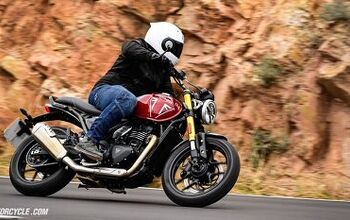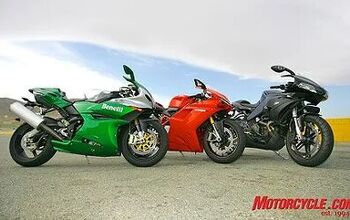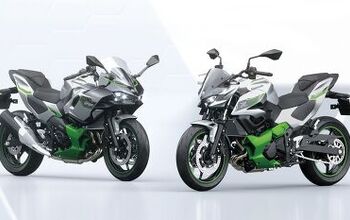Church of MO: 2002 Suzuki DL1000 V-Strom
And while we’re on the topic of great Suzukis, 2022 marks the 20th anniversary of its very successful V-Strom, and possibly the real beginning of the Adventure Bike era that BMW semi-invented. About the turn of the century, the leading edge of Boomers began looking for motorcycles that didn’t hurt their aging backs, but still made them look like swashbuckling action heroes to people who didn’t know any better. Suzuki followed its usual formula to great success: Keep it light, simple, powerful and affordable.
Strommin’ On the Ol’ Banjo
That’s not so heavy at all really; in fact it’s 30 pounds less than the new Honda VFR800 (if Motorcyclist magazine’s scales are accurate, that is… the same publication has the BMW R1150GS at 586 pounds wet, and a ’99 Triumph Tiger at 550).
Light is, surprisingly enough, just the way the bike feels, too. Once in the saddle, levering the thing upright from the sidestand with the nice handlebar requires about half the effort you’d guess from looking at the beast, and the lithe theme grows stronger with every Taco Bell curb you hop in your own little Paris-Dakar fantasy world. Welcome to Suzuki’s all-new “Sport Enduro Tourer.” Listen, Suzuki’s copywriter is better payed than me, so take it away:… Underneath the trapping of responsible citizenship, some people dream of more.
A place where the horizon is defined by tall trees instead of tall buildings. Where grass doesn’t just grow in a park, Where animals don’t only live in a zoo. Where the wind blows clear ands strong and doesn’t carry the smell of a traffic jam.
A place like Africa. From meandering tracks through broad plateaus bordered by the Drakensburg Mountains of the coastal (sic) near Durban, South Africa. To hard-packed switchback roads carved into the side of a gorge in the Atlas Mountains of Morocco. From vast savanna grasslands to towering peaks. Now there is a motorcycle inspired by that dream, and built for adventure. Named for its V-twin engine and the stream of wind, or “Strom” in German. It is called the Suzuki V-Strom 1000. Ready to live the adventure in your mind.
“Theeeeere’s a plaaaace that I dreamed of, oooonce in a lulllllabyyyyye….” right, why not appeal to the same set of fantasies that have made things like Ford Explorers so amazingly successful? With its relatively light weight and reasonably good suspension and balance, the V-Strom actually feels like it wouldn’t be too unwieldy off-piste, but in fact Suzuki (American Suzuki, at least) is careful to not imply in any way, shape, or form that it’s a big dirt bike. Just as well, probably: Just as few sport-utes ever dirty their tires, it’s unlikely that the V-Strom will be a victim of the type of wanderlust described by its marketeers. What it is, really, is simply a cosmetic treatment applied to what we used to refer to as a “standard” bike, an appellation that’s sort of the kiss of death for most buyers: Standard has come to be synonymous with Boring.
In any case, the DL, once past the hyperbole and marketing Strom-job, is a nicer motorcycle than it looks, depending of course on what you think of its looks. Its 996cc L-twin, sourced from the TL1000, has found itself a nice home, hanging there beneath a twin-spar aluminum alloy frame. A 43mm cartridge fork sees the the front 19-inch wheel sternly through any asphaltic upheaval, while a single linkage-mounted shock continues the long-travel-yet-controlled theme out back. In between, a nice long seat offers quite a bit of wiggle room for long, dull days in the saddle–along with the ability to act the hanging-off, scooting-around fool when the time comes to attack squiggly backroads.
We’ve said it a hundred times about the BMW GS series: You won’t believe how well such an ungainly looking thing attacks corners, and the V-Strom assaults that concept from a slightly different direction: It doesn’t quite have the BMW’s chassis, but it does have a lot more POWAH. Numbah One Thing is the handlebar; high and wide, the ‘Strom bar gives a feeling of complete dominance over front-wheel direction, even if the stiffish front end means you don’t get a lot of front-end feel. Number two would be low, forwardish footpeg placement. The V-Strom goes further in the big-dirt-bike direction, though, by providing a seat/fuel tank junction shape designed with sporty riding in mind; ie, skinny between the thighs and with plenty of room to shift your bulk forward, as you throw it into the corner, and rearward, as you wheelie out like the big juvenile you are.
We are not sure why Suzuki stuck the 19-inch front wheel on there, really. We can only surmise it was a style thing; imagine how heavy the front would look perched over a normal 17-inch wheel. You’d expect less grip from a 110-section tire on a 2.5-inch rim than you would from the typical 17-incher, but the bigger wheel’s contact patch is slightly longer, at least, and in fact you can go ahead and fling the DL into corners with your classic wreckless abandon. Not that you really do. Something about the DL feels enough like an overgrown dirt bike that you don’t ride it like a sportbike so much (ie, really trusting the front to grip). Instead, you find yourself sidling up to tight corners slower and slightly sideways, and waiting for the magical moment when you whack the throttle open again. If you’re leaned over enough or if the exit’s a little dirty, so much the better; the DL spins up the rear semi-knobby and scoots out, bar waggling, in a highly inflammatory manner, and again, you’re in complete control thanks to that wide handlebar. It’s as safe as sex with a handcuffed opponent.
Your brakes are not exactly cutting-edge either–two-piston slide-type calipers grab the front 310mm discs. Yet again, in finest dirt-bike style, you find yourself using the rear more on the DL than upon your typical sportbike, and with the bike’s long-travel suspension, really grabby brakes wouldn’t be completely useful anyway.
Naturally, Suzuki’s engineers couldn’t be content with just leaving the perfectly nice TL twin alone and sticking it in there, that would’ve been way too easy. To make it more suited to “adventure touring use,” DL intake valves were shrunk 4mm to 36, and different intake and exhaust cams have less duration and lift than the TL pieces. (Suzuki’s nice idler-gear cam drive system remains in place, which lets you lift the cams right out for valve adjustments without having to disturb the chain at all.) While they were in there, the DL got forged aluminum pistons instead of the TL’s cast ones, and new, shot-peened rods, both of which changes combined reduce reciprocating weight by 90 grams.
The DL’s throttle bodies got shrunk too, all the way from 52 to 45mm, and inside them you’ll find the same Suzuki Dual Throttle Valve System used on its GSX-Rs: your right paw activates the lower butterfly in each throttle body, and the bike’s 16-bit computer opens the upper one as it sees fit. It’s effective, too; the bike has very nice power delivery from down low, and Suzuki’s claim that SDTV helps fuel mileage seems borne out by the fact our bike averages around 44 mpg in normal use, giving it a range of well over 200 miles.
It’s a tasty motor indeed, matter of fact, which begins cranking out over 60 foot-pounds of torque down at 4000 rpm (Aprilia’s CapoNord only makes 57.6 foot-pounds at its 6800 rpm peak), and revs on to produce a class-leading 91 horses at 8200 rpm, too. Combine that power with the DL’s light weight, and you’re looking at the most potent adventure tourer by quite a ways–and yet… what would’ve been so wrong with leaving the TL engine alone and giving the world a 115-horsepower adventure tourer? We know not.
In the gearbox, too, a bit of reshuffling took shape: the DL has a shorter second gear than the TL (nice for off-road use), and an overdriven sixth instead of the TL’s 1:1 top gear. A 41-tooth sprocket, then, gives the TL an overall ratio of 4.049 (4.049 engine revolutions per rear tire revolution) to the TL’s 4.11 ratio. (Our bike more than occasionally hangs fire on the 2-3 upshift.)
More by John Burns


































Comments
Join the conversation
Bought my '02 used in the fall of '02 in a private sale.
This article probably helped convince me to get one.
Good bike, owned it for 12 years, did everything asked of it with no major issues.
Put some emulators and a good (Race Tech, IIRC) fully adjustable shock on it, did wonders for the ride.
Never did get to the point that I thought it looked good (especially in grey), except from some very specific angles. Especially after I installed the really tall (but still below eye height) windshield looking for some relief from the buffeting.
Ah, a bike unsure what ADV meant during the pre beak era. Such a great time...